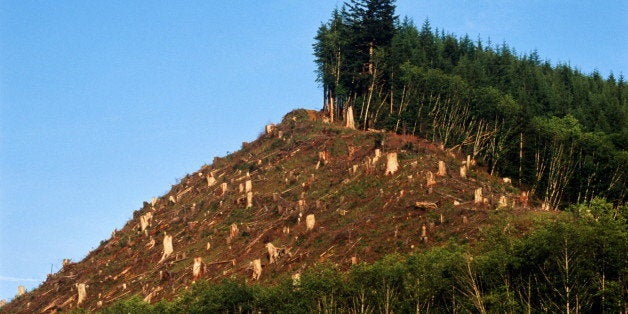
One of the largest contributors to climate change is deforestation, accounting for 15 percent of all global greenhouse gas emissions. This driver, however, does not receive sufficient attention in climate discussions in developed countries, since the most threatened forests tend to be in developing countries in Latin America, Africa, and Asia. Although international negotiations, governments, and NGOs address deforestation as a climate change driver, we feel that deforestation should be discussed more thoroughly in industrialized nations not only because climate change impacts are transnational, but also because through globalization deforestation is tied to the developed world's demand for resources. This post provides a basic understanding of deforestation, how the international community and other actors are tackling the issue, and what we can do about it in our everyday life.
A global issue
As trees store carbon dioxide (CO2) in their wood, forests contain a large amount of CO2 that is kept out of the atmosphere as long as the trees are not cut down, also known as the 'carbon sink' phenomena. With deforestation, all this CO2 is released into the atmosphere and contributes to climate change. Additionally, there are various other negative impacts of deforestation aside from climate change, including the upsetting local livelihoods and communities, and the loss of biodiversity. When we look at some of the root causes of deforestation we see that it is largely an economic issue fueled by demands for specific goods in both developed and developing countries.
These are 5 chief causes of deforestation:
- Commercial Agriculture & Agribusiness: Cattle ranching for beef, land for growing soybeans and palm oil for a wide variety of products. In 2012, agriculture was reported as being the direct driver of 80 percent of global deforestation.
- Logging and Paper Product Production: Commercial logging activities account for more than 70 percent of total degradation in Latin America and Asia.
- Mining: For aluminum, gold, and copper.
- Subsistence Farming and Fuel Production: Staple crop cultivation and charcoal production, firewood collection for cooking, heat fuel purposes. These tend to be the largest drivers of degradation in most of Africa.
- Infrastructure: Roads and hydroelectric dams. Furthermore, once roads are built, this accessibility often allows for more of the forest to be susceptible to further deforestation.
Forests are usually threatened by a combination of these factors, and the most prevalent threat does vary by forest. For example, although deforestation has slowed in recent years in the Amazon, deforestation mainly driven to satisfy the global demand for cattle and soybeans. Other forests such as the Madagascar Rain Forest are cleared to supply international demand for their unique woods such as ebony and rosewood.
What the world is doing
Governments, international organizations, and NGOs continue working to reduce rates of deforestation through policy, and two powerful developments include recognizing the power of economic incentives and technological innovation. For example, through the market-based mechanism UN-REDD+, developed countries or companies receive carbon credits to offset their own footprint by paying not to cut down forests in developing countries. Although better governance, transparency, and quantifying metrics are needed, policy approaches that focus on the economics of the situation is key. The use of technology also continues to minimize obstacles that have held back the ability to monitor and enforce regulations that are in place. For example, GIS mapping and World Resources Institute (WRI)'s Global Forest Watch powered by Google provide accurate and up to data on forest cover. A recent kick-starter campaign for Rainforest Connection (RFCx) has already surpassed request for funding allowing them to combat illegal logging. This start-up transforms recycled cell-phones into autonomous, solar-powered listening devices that can monitor and pinpoint chainsaw activity and makes data available in real-time to anyone, anywhere.
What you can do
Although factors contributing to deforestation can be locally fueled (such as subsistence farming and fuel production), many factors are actually linked to international consumption. By using our purchasing choices we can combat deforestation in our daily lives.
- Purchase third-party certified products such as Rainforest Alliance Certification (which certifies products as diverse as chocolate, skin care, and tea) and wood & paper products with Forest Stewardship Council (FSC) certification
- Instead of buying new wood products, buy used or recycled and maximize use of post consumer recycled wood, pulp, paper and fiber in their products
- Eat less meat. Growing demand for meat requires more land for cattle ranching and for cultivating crops for animal feed. Look for Rainforest Alliance certified cattle products when you do buy meat
- Support brands who have committed to zero deforestation policies: Nestle, Unilever, Mars, L'Oreal, Procter & Gamble and Colgate-Palmolive
- Use less paper wherever you can: Reduce what you print at the office and at home, and turn on paperless billing for your accounts. Also, make sure to recycle (or compost) the paper that you aren't using anymore, instead of allowing it to end up in the landfill
- Plant a tree or participate in activist and conservation campaigns that work to protect forests worldwide from deforestation. There are some great campaigns like Nature Conservancy's Plant a Billion Trees.
Although many might say that an individual's purchasing decisions have a minimal impact, it is everyone's responsibility to understand the environmental effects of their consumption, and an aggregate shift can have an impact. Efforts by governments, international organizations, and NGOs are very valuable and do need to continue, but should be complementary to changes in our global consumption behaviors to tackle the underlying causes of deforestation. Although deforestation is occurring more frequently in developing countries, it is our responsibility as well to mitigate climate change.